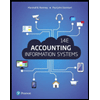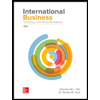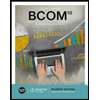Business ethic week 4
.docx
keyboard_arrow_up
School
University Canada West *
*We aren’t endorsed by this school
Course
601
Subject
Business
Date
May 14, 2024
Type
docx
Pages
6
Uploaded by SuperHumanWasp4238 on coursehero.com
Business ethics
Group 1
Manvinder kaur- 2308002
Gaurav Pawar- 2326753
Varshil- 2323320
Oluwatosin Adetutu Ogunsola- 2319212
Date: 1 May 2024
Professor name- Abhinav Tomar
Question 1. What are the ethical implication in this example of corporate social responsibility?
Customers may find it awkward to donate via registration process, which can make them feel bad or even forced to contribute. Not all people can take part and some may have their favorite organizations and not the one to be picked here. Thus, the onlookers may experience this phenomenon
of guilt when others in the line do not give anything and follow their desire to grab any meals they want. The companies could try gentle collection of benevolent donation tools to make sure that there was no distress among the customers. Such may range from online donation buttons at physical donation boxes to those who trigger other actions as long they are not yet in the act of soliciting.
Customers may have allergic reaction to donation requests – which they suspect are not credible due to low transparency – at checkout. They doubtfully tend to always ask a question about how much their non-taxable donation would be redirected to third party. This is what brings about doubts according to the lack of transparency. The same level of accountability, which is implemented by large corporations can be missing on smaller retailers that can even be an issue for further concern.
This sure represents a serious fact that these individuals and even organizations can use the noble intentions tricking people creating it into a con.
In addition, shopping center employees who undertake the non-selling tasks and so contributing in charity work become very busy that some of them develop excessive stress. Events like these may be very time-consuming or they can require special training that makes the main job less interesting, which threatens with the turning the employees into the person who spends the majority of time working with this difficult task and the situation of being overwhelmed by work.
The question of ethics around CSR fundraising schemes is not a matter of chief. Companies may use the social programs purposefully as a tool to market their band image or obtain tax credits that do not contribute to the community initiatives. Some of the CSR programs, in turn, have been
executed as a cover to unethical business vices. So, the phrase arises that what really is the reason of these heavenly philanthropic works.
Question 2. What information should the company provide to Suzanne and its
customer?
To address Suzanne's concerns and ensure transparency and accountability in the
donation scheme, the company should provide the following information to both Suzanne and
its customers: To address Suzanne's concerns and ensure transparency and accountability in
the donation scheme, the company should provide the following information to both Suzanne
and its customers:
1
.
Purpose and Impact:
Unambiguously present the main goal of the fundraising and show
clearly how the received money will be utilized to help the neighbourhood animal shelter.
Provide a fund- raising program illustrating your argument that the donations will affect the
shelter and the animals living there positively.
2
.
Opt-In Policy
:
To comply with this, develop an opt-in system in which participants are
given the chance to donate, not being made to without their consent. These devices are a great
relief of the customers burden and grant autonomy to them.
3. Alternatives:
Present also various means of the customers involvement in the
implementation if they do not want to contribute to funding at the counter moment. These can
be carried out by giving detail of what methods are to be used (i.e. donating directly to the
shelter, or volunteering).
4.
Transparency
:
Indicate proportion of donation to the charitable organization that goes to
the needy directly, and any administrative fees or overhead cost associated with the operation.
It makes the communication process engaging and clear, which ultimately boosts customer
confidence.
Your preview ends here
Eager to read complete document? Join bartleby learn and gain access to the full version
- Access to all documents
- Unlimited textbook solutions
- 24/7 expert homework help
Related Questions
25-Oman Tel developed a set of principles that promote and guide fair and responsible use of information and information systems (IS). This collection of principles is called: O a Code of ethics b IS Responsibility plan O c IS Privacy plan IS D Risk plan
arrow_forward
True or False: Some individuals oppose any business activity involving social responsibility because it cuts into profits for investors.
Question 28 options:
True
False
arrow_forward
Q6. How important is it to achieving ethical standards in business?
arrow_forward
Environmental analysis (maximum 400 words across all factors)
1. The PEST(EL) analysis highlights various macro-level environmental factors. Consider the macroenvironment for the Banking Industry and identify and analyze those factors that are currently or likely to affect your industry. If certain factors are more important, please elaborate on those. Please provide detail on the key factors and how you expect that they might affect your industry in the future.
arrow_forward
QUESTION 4
Put the suitable name of the following definitions (ethics- moral values - conflict of interest-
dilemma)
Situations in which moral reasons come into conflict ( obligations, rights, goods, ideals)
arrow_forward
QUESTION 4
Put the suitable name of the following definitions (ethics – moral values - conflict of interest-
dilemma)
Situations in which moral reasons come inte conflict ( obligations, rights, goods, ideals)
arrow_forward
You have recently obtained employment at RL Ltd. The manager of this successful medium sized business enterprise is keen to implement and formalize some ethical practices in the business.
She asks you and your team provide detailed overview about a current ethical issue(s) which affects any well-known company of your choice.
Required:
Research and report on the unethical issue/s affecting the company
Examine how the unethical issue/s has impacted the business
Examine the company's ethical code of conduct or a statement of corporate social responsibility. To what extent is it following the code?
Make recommendations on how the company could resolve the unethical issue/e and also how they can also improve the ethics of its operations.
arrow_forward
Please
arrow_forward
business ethics
Question 11
What are the three different types of stakeholder theory according to Donaldson and Preston (1995)?
ONormative, Descriptive and Economic
Normative, Moral and Instrumental
Political, Descriptive and Instrumental
ONormative, Descriptive and Instrumental
arrow_forward
Ethics If a company knows that a snack or beverage is
typically consumed in a single sitting (such as a bottle
of soda or a bag of chips), is it ethical for that com-
pany to include on the product's nutrition label values
based on the identification of multiple servings within
the product (that is, the nutrition values displayed
would represent a single serving of the product that
is less than the whole product, making it necessary
to multiply those values by the number of servings to
identify the total nutritional value of the package)?
arrow_forward
conclusion and recommendations on topic of "rising food prices: causes and consequence" in Jamaica
arrow_forward
Which of the following do proponents of the broader view of corporate social responsibility believe? Question 19 options: Businesses have other obligations besides making a profit. The modern corporation is not a social institution. Moral responsibility arises from social power. Corporations should not internalize their externalities.
arrow_forward
Required:
• Identify the issue/problem
• Prepare Alternative Courses of Action
• Recommend the best course of action.
arrow_forward
Business Ethics question:
1. Should ads directed at children be banned by the government? Support your answer.
arrow_forward
com/courses/1788/quizzes/26493/take
OMO
围 Read
1st Sem MLA .
V Question 8
Question 1
1 pts
Time Running: Hide
incements
Attempt due: Dec 10 at 11:59pm
1 Minute, 48 Seconds
What is the minor term in this syllogism?
aments
All vehicles are instruments of transportation;
ssions
But jeep is a vehicle:
es
Therefore jeep is an instrument of transportation.
le
O none of the above
O vehicle
bus
O transportation
zzes
O jeep
dules
BlueButton
nferences)
llaborations
Question 2
1 pts
fice 365
pogle Drive
How many terms are present in this categorical syllogism?
9:21 AM
26°C
A D D A 4)
ere to search
12/10/2021
ASUS
arrow_forward
1. What is meant by social responsibility? What is sustainable development? (from Chapter 3)
2. Describe the purchase decision process (the five stages a buyer passes through in making choices about which products and services to buy.) (from Chapter 4)
arrow_forward
read and answer question
Chapter 5: Ethics and The Environment (Page: 264)
“The Auto Companies in China”
arrow_forward
Scenario 1: Receiving GiftsYou are the Director of Contracts at the Ministry of Energy. During theChristmas season, one of the Oil and Gas Companies sent a hamperof expensive goodies personally addressed to you at the office. Whatactions might you want to take? Consider the alternatives you have available to you and how they affect the stakeholders. What are the consequences, duties, rights, and principles, implications for personal integrity and character? Can you please include references for this answer?
arrow_forward
signment 1.pdf
瓦,
3.
| 4
125%
McDonald's
happy
meal
official sponsor
10
DHS
Free Toy with
every Happy Meal
For s ed per
I'm lovin' it
https://michaelsnooksite.wordpress.com/2013/12/03/the-ethical-issue-of-advertising-to-children/
Argue whether you feel this advert is unethical and if 'advertising to children' should be allowed in
South Africa. Conduct additional research in order to justify your answer. You may also use
additional examples to support your answer.
arrow_forward
Subject-Business law
Q1-Describe the steps to take in devising a legal risk management plan
Q2-Why do business people increasingly opt for ADR rather than civil litigation to resolve disputes ?
arrow_forward
Article 1: Lancewood launches the first double cream lactose-free yoghurt in SA
Lancewood recently launched Lactose-Free Tropical Fruit Yoghurt, which was intended to appeal to two key consumer segments: real, full fat dairy fans and those who may be lactose-sensitive or intolerant – both of whom can now enjoy the delicious, extra creamy and fruity taste that this yoghurt has to offer. The lactose free yoghurt is made by adding a lactase enzyme that breaks down the lactose sugar into glucose and galactose. While this is the only flavour offered in double cream format, Lancewood does have two low fat flavour choices in lactose free.
“Consumers are constantly looking for new and delicious ways to spoil themselves. With our expanding yoghurt range, we strive to offer the perfect flavour for every moment to meet various consumer demands. Whether you’re following a specific diet, looking for a pick me up, protein boost, convenient snack or simply craving an indulgent treat, Lancewood has…
arrow_forward
Article 1: Lancewood launches the first double cream lactose-free yoghurt in SA
Lancewood recently launched Lactose-Free Tropical Fruit Yoghurt, which was intended to appeal to two key consumer segments: real, full fat dairy fans and those who may be lactose-sensitive or intolerant – both of whom can now enjoy the delicious, extra creamy and fruity taste that this yoghurt has to offer. The lactose free yoghurt is made by adding a lactase enzyme that breaks down the lactose sugar into glucose and galactose. While this is the only flavour offered in double cream format, Lancewood does have two low fat flavour choices in lactose free.
“Consumers are constantly looking for new and delicious ways to spoil themselves. With our expanding yoghurt range, we strive to offer the perfect flavour for every moment to meet various consumer demands. Whether you’re following a specific diet, looking for a pick me up, protein boost, convenient snack or simply craving an indulgent treat, Lancewood has…
arrow_forward
Article 1: Lancewood launches the first double cream lactose-free yoghurt in SA
Lancewood recently launched Lactose-Free Tropical Fruit Yoghurt, which was intended to appeal to two key consumer segments: real, full fat dairy fans and those who may be lactose-sensitive or intolerant – both of whom can now enjoy the delicious, extra creamy and fruity taste that this yoghurt has to offer. The lactose free yoghurt is made by adding a lactase enzyme that breaks down the lactose sugar into glucose and galactose. While this is the only flavour offered in double cream format, Lancewood does have two low fat flavour choices in lactose free.
“Consumers are constantly looking for new and delicious ways to spoil themselves. With our expanding yoghurt range, we strive to offer the perfect flavour for every moment to meet various consumer demands. Whether you’re following a specific diet, looking for a pick me up, protein boost, convenient snack or simply craving an indulgent treat, Lancewood has…
arrow_forward
Article 1: Lancewood launches the first double cream lactose-free yoghurt in SA
Lancewood recently launched Lactose-Free Tropical Fruit Yoghurt, which was intended to appeal to two key consumer segments: real, full fat dairy fans and those who may be lactose-sensitive or intolerant – both of whom can now enjoy the delicious, extra creamy and fruity taste that this yoghurt has to offer. The lactose free yoghurt is made by adding a lactase enzyme that breaks down the lactose sugar into glucose and galactose. While this is the only flavour offered in double cream format, Lancewood does have two low fat flavour choices in lactose free.
“Consumers are constantly looking for new and delicious ways to spoil themselves. With our expanding yoghurt range, we strive to offer the perfect flavour for every moment to meet various consumer demands. Whether you’re following a specific diet, looking for a pick me up, protein boost, convenient snack or simply craving an indulgent treat, Lancewood has…
arrow_forward
Article 1: Lancewood launches the first double cream lactose-free yoghurt in SA
Lancewood recently launched Lactose-Free Tropical Fruit Yoghurt, which was intended to appeal to two key consumer segments: real, full fat dairy fans and those who may be lactose-sensitive or intolerant – both of whom can now enjoy the delicious, extra creamy and fruity taste that this yoghurt has to offer. The lactose free yoghurt is made by adding a lactase enzyme that breaks down the lactose sugar into glucose and galactose. While this is the only flavour offered in double cream format, Lancewood does have two low fat flavour choices in lactose free.
“Consumers are constantly looking for new and delicious ways to spoil themselves. With our expanding yoghurt range, we strive to offer the perfect flavour for every moment to meet various consumer demands. Whether you’re following a specific diet, looking for a pick me up, protein boost, convenient snack or simply craving an indulgent treat, Lancewood has…
arrow_forward
Ethical Issue Evaluation
1. Which ethical approach do you think is the most applicable to justify autonomous or self-driving cars?
arrow_forward
Integrity, Objectivity, and Ethics in Business Loan Loss Woes
During the economic crisis of 2008, many of the largest U.S. banks were accused of
having provided mortgages to marginally qualified borrowers. Such loans, called
"sub-prime" and "Alt-A" loans, were made to earn mortgage fees. When the
borrowers were unable to pay their mortgages, the banks incurred large losses on
defaulted loans. These losses were so large that the U.S. government had to provide
money (TARP funds) to many banks to bail them out of their financial distress.
During the middle of the crisis, the FASB voted to provide banks more flexibility in applying fair value
accounting for bank assets, such as defaulted loans. These FASB rule changes allowed banks to
minimize the impact of their defaulted loan write-downs and improve their earnings. Some criticized
the FASB as succumbing to political pressure and reducing overall financial statement fairness.
Source: lan Katz, "FASB Eases Fair-Value Rules Amid Lawmaker…
arrow_forward
Question 9
Donald puts a lot of money into a bucket and gives Bernie a power of appointment over the money in the bucket. Bernie has the power to distribute that money only to himself, his creditors, his estate, or his estate's creditors. What is the correct name for his power of appointment? It is a/an:
General power of appointment
Limited power of appointment
Question 10
True or False. The spousal consent rules for the annual exclusion require the non-donor spouse to consent to all gifts made by the donor spouse in that year; he or she cannot select which gifts he or she will join and which he or she will not.
True
False
arrow_forward
Scenario 1: Receiving GiftsYou are the Director of Contracts at the Ministry of Energy. During theChristmas season, one of the Oil and Gas Companies sent a hamperof expensive goodies personally addressed to you at the office. Whatactions might you want to take? Consider the alternatives you have available to you and how they affect the stakeholders. What are the consequences, duties, rights, and principles, implications for personal integrity and character?
arrow_forward
Q4
(a)
Explain FOUR (4) ethical principles for managing ethics in information society.
arrow_forward
SEE MORE QUESTIONS
Recommended textbooks for you

BUSN 11 Introduction to Business Student Edition
Business
ISBN:9781337407137
Author:Kelly
Publisher:Cengage Learning

Essentials of Business Communication (MindTap Cou...
Business
ISBN:9781337386494
Author:Mary Ellen Guffey, Dana Loewy
Publisher:Cengage Learning

Accounting Information Systems (14th Edition)
Business
ISBN:9780134474021
Author:Marshall B. Romney, Paul J. Steinbart
Publisher:PEARSON


International Business: Competing in the Global M...
Business
ISBN:9781259929441
Author:Charles W. L. Hill Dr, G. Tomas M. Hult
Publisher:McGraw-Hill Education

Related Questions
- 25-Oman Tel developed a set of principles that promote and guide fair and responsible use of information and information systems (IS). This collection of principles is called: O a Code of ethics b IS Responsibility plan O c IS Privacy plan IS D Risk planarrow_forwardTrue or False: Some individuals oppose any business activity involving social responsibility because it cuts into profits for investors. Question 28 options: True Falsearrow_forwardQ6. How important is it to achieving ethical standards in business?arrow_forward
- Environmental analysis (maximum 400 words across all factors) 1. The PEST(EL) analysis highlights various macro-level environmental factors. Consider the macroenvironment for the Banking Industry and identify and analyze those factors that are currently or likely to affect your industry. If certain factors are more important, please elaborate on those. Please provide detail on the key factors and how you expect that they might affect your industry in the future.arrow_forwardQUESTION 4 Put the suitable name of the following definitions (ethics- moral values - conflict of interest- dilemma) Situations in which moral reasons come into conflict ( obligations, rights, goods, ideals)arrow_forwardQUESTION 4 Put the suitable name of the following definitions (ethics – moral values - conflict of interest- dilemma) Situations in which moral reasons come inte conflict ( obligations, rights, goods, ideals)arrow_forward
- You have recently obtained employment at RL Ltd. The manager of this successful medium sized business enterprise is keen to implement and formalize some ethical practices in the business. She asks you and your team provide detailed overview about a current ethical issue(s) which affects any well-known company of your choice. Required: Research and report on the unethical issue/s affecting the company Examine how the unethical issue/s has impacted the business Examine the company's ethical code of conduct or a statement of corporate social responsibility. To what extent is it following the code? Make recommendations on how the company could resolve the unethical issue/e and also how they can also improve the ethics of its operations.arrow_forwardPleasearrow_forwardbusiness ethics Question 11 What are the three different types of stakeholder theory according to Donaldson and Preston (1995)? ONormative, Descriptive and Economic Normative, Moral and Instrumental Political, Descriptive and Instrumental ONormative, Descriptive and Instrumentalarrow_forward
- Ethics If a company knows that a snack or beverage is typically consumed in a single sitting (such as a bottle of soda or a bag of chips), is it ethical for that com- pany to include on the product's nutrition label values based on the identification of multiple servings within the product (that is, the nutrition values displayed would represent a single serving of the product that is less than the whole product, making it necessary to multiply those values by the number of servings to identify the total nutritional value of the package)?arrow_forwardconclusion and recommendations on topic of "rising food prices: causes and consequence" in Jamaicaarrow_forwardWhich of the following do proponents of the broader view of corporate social responsibility believe? Question 19 options: Businesses have other obligations besides making a profit. The modern corporation is not a social institution. Moral responsibility arises from social power. Corporations should not internalize their externalities.arrow_forward
arrow_back_ios
SEE MORE QUESTIONS
arrow_forward_ios
Recommended textbooks for you
 BUSN 11 Introduction to Business Student EditionBusinessISBN:9781337407137Author:KellyPublisher:Cengage Learning
BUSN 11 Introduction to Business Student EditionBusinessISBN:9781337407137Author:KellyPublisher:Cengage Learning Essentials of Business Communication (MindTap Cou...BusinessISBN:9781337386494Author:Mary Ellen Guffey, Dana LoewyPublisher:Cengage Learning
Essentials of Business Communication (MindTap Cou...BusinessISBN:9781337386494Author:Mary Ellen Guffey, Dana LoewyPublisher:Cengage Learning Accounting Information Systems (14th Edition)BusinessISBN:9780134474021Author:Marshall B. Romney, Paul J. SteinbartPublisher:PEARSON
Accounting Information Systems (14th Edition)BusinessISBN:9780134474021Author:Marshall B. Romney, Paul J. SteinbartPublisher:PEARSON
 International Business: Competing in the Global M...BusinessISBN:9781259929441Author:Charles W. L. Hill Dr, G. Tomas M. HultPublisher:McGraw-Hill Education
International Business: Competing in the Global M...BusinessISBN:9781259929441Author:Charles W. L. Hill Dr, G. Tomas M. HultPublisher:McGraw-Hill Education

BUSN 11 Introduction to Business Student Edition
Business
ISBN:9781337407137
Author:Kelly
Publisher:Cengage Learning

Essentials of Business Communication (MindTap Cou...
Business
ISBN:9781337386494
Author:Mary Ellen Guffey, Dana Loewy
Publisher:Cengage Learning

Accounting Information Systems (14th Edition)
Business
ISBN:9780134474021
Author:Marshall B. Romney, Paul J. Steinbart
Publisher:PEARSON


International Business: Competing in the Global M...
Business
ISBN:9781259929441
Author:Charles W. L. Hill Dr, G. Tomas M. Hult
Publisher:McGraw-Hill Education
